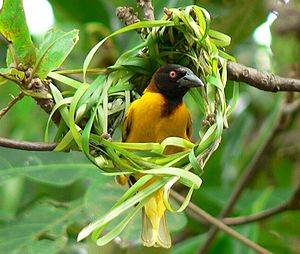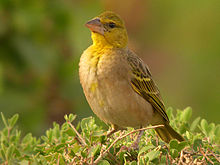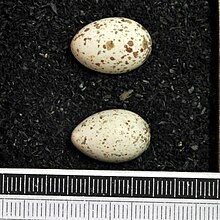Village weaver
| Village weaver | ||||||||||||
|---|---|---|---|---|---|---|---|---|---|---|---|---|

Village weaver ( Ploceus cucullatus ), male building a nest |
||||||||||||
| Systematics | ||||||||||||
|
||||||||||||
| Scientific name | ||||||||||||
| Ploceus cucullatus | ||||||||||||
| ( Statius Müller , 1776) |
The village weaver ( Ploceus cucullatus , synonym Textor cucullatus ), also called Textorweber , is a species from the family of weaver birds (Ploceidae). It used to be classified in the genus Textor .
Appearance
The village weaver reaches a height of 15 to 18 centimeters. The males wear bright yellow plumage during courtship. The head and wings are black feathered. Outside the courtship season, the plumage of the males resembles that of the females. It is then greenish in color with fine dotted lines.
Way of life
Textor weavers are lively and noisy colony breeders who build their kidney-shaped hanging nests out of grass close together. While the nest is being built, the males can often be seen hanging upside down from branches with flapping wings.
The eggs are incubated and the young birds are raised mainly by the females.
Distribution and habitat
Village weavers come from Sudan and southern Ethiopia to Angola and the Cape Province of South Africa . In this distribution area they settle on the edge of forests as well as agricultural areas and village areas.
Evolutionary defense against brood parasitism
Village weavers in the regions of Africa are often exposed to the brood parasitism of the gold cuckoo ( Chrysococcyx caprius ). In the course of evolution, village weavers have therefore developed an effective defense. They lay individually marked spotted or colored eggs that they can easily distinguish from eggs placed under them. The evolutionary biologist David Lahti of the University of Massachusetts Amherst examined breeding colonies on the islands of Hispaniola and Mauritius , to which village weavers were introduced by humans in 1790 (Hispaniola) and 1886 (Mauritius) and which show no occurrence of parasitic parasites, and compared the eggs with those of the breeding colonies in Gambia and other African regions in South Africa . The result was that the individual marking pattern of the eggs in the village weavers on both islands regressed. The eggs were less spotted and colored. Especially on Hispaniola there was a marked regression of the markings, on Mauritius the regression of the recognition pattern in the eggs was less marked.
literature
- Horst Bielfeld : Knowing and caring for 300 ornamental birds. Ulmer Verlag, Stuttgart 2009, ISBN 978-3-8001-5737-2 .
Web links
- Studies by evolutionary biologist David Lahti
- Ploceus cucullatus in the endangered Red List species the IUCN 2008. Posted by: BirdLife International, 2008. Accessed on December 22 of 2008.
- Videos, photos and sound recordings of Ploceus cucullatus in the Internet Bird Collection
- SASOL e-guide


